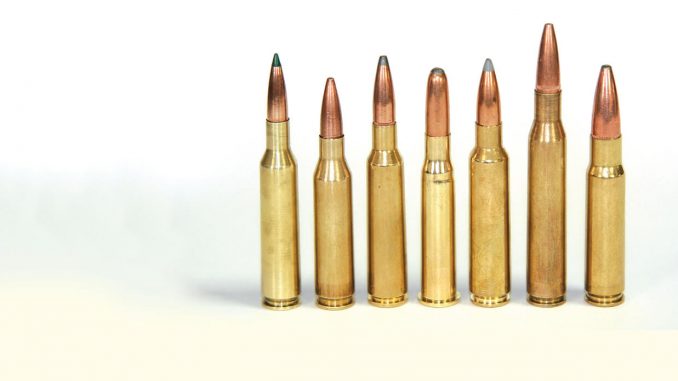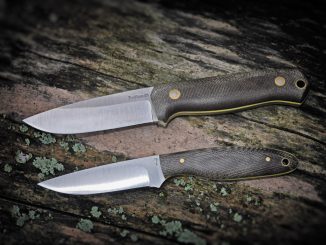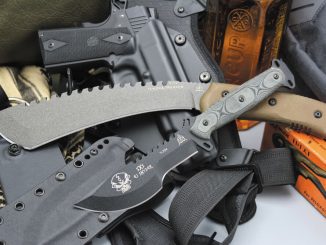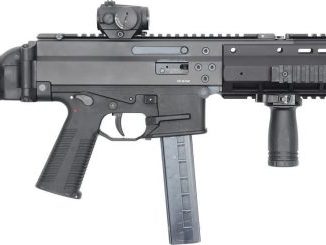
I guess rifle cartridges are no different than Hollywood actors, clothing fashion or automobiles. The intricacies of why one cartridge becomes popular and another fades into oblivion are often just one of those mysteries with no quantifiable answer.
Although obvious marketing blunders are sometimes to blame, the many moving parts of rifle and ammunition R&D, combined with disconnected marketing departments simply not in synch (for example, the .250 Savage); awesome cartridges rolled out in the wrong rifle models or actions (6.5 Remington Magnum or .280 Remington); rifles introduced with flawed rifling twists (.244 Remington); or simply the right round marketed for the wrong job (5mm Remington Magnum Rimfire) could all be reasons.
Of course, every rifle loony has their favorite obscure rifle cartridge, convinced some niche chambering is the answer to their particular shooting needs. All the Weatherbys, Winchester Short Magnums or Ackley Improveds fit here— they are ballistically awesome but not exactly mainstream.
The real problem with many failed cartridges is that they’re surrounded by readily available options with similar capabilities that have been around forever and are offered in a wide variety of rifle and ammo options (i.e., .270 Winchester, .308 Winchester, .30-06 Springfield). Then, there are those rare instances when rifle and ammo manufactures put their heads together, communicate effectively and hit a home run, such as the 6.5 Creedmoor.
Still, there is no denying there are cartridges out there that fill important niches and improve on ballistics of morepopular rounds in their class. But, for whatever reason, they just never gained traction. That is the topic here: seven deer-hunting cartridges that should be more popular but just never caught on.
6MM REMINGTON
Introduced in 1955 as the .244 Remington (a neckeddown .257 Roberts with the shoulder angle increased to 32 degrees), it was envisioned by Remington as a long-range/ windy-day varmint rifle, equipping Model 722 rifles with slow, 1:12 rifling. Winchester introduced its .243 the same year but had the foresight to understand that blue-collar shooters might prefer a rifle suited to both varmint and deer-hunting duties. So, Winchester included a 1:10 rifling twist to stabilize heavier bullets. The .243 Win. skyrocketed; the .224 Rem. withered on the vine.
Realizing its miscalculation, Remington rebranded the .244 as the 6mm Remington (what it’s known as today) in 1963 in the newly minted Model 700, including 1:9 rifling and the current 6mm Remington moniker. But it was too late; the .243 Win. had already captured the hearts of American shooters.
That’s a shame, because the 6mm is undoubtedly the superior cartridge. It has slightly more powder capacity that improves velocities by 100 to 150 fps, higher SAMMI pressures and a longer neck to better accommodate long-for-caliber bullets. As examples, loaded with a high-BC 95-grain Berger VLD Hunting to 3,200 fps or a 100-grain Speer BTSP to 3,000, the 6mm produces remarkable accuracy and deadly deer “medicine.”

The 6mm Remington. There are darned few 6mm cartridges to begin with, but the .243 Winchester won that battle long ago. The 6mm Remington retains dedicated fans and is regaining popularity with the long-range shooting crowd.
.260 REMINGTON
I’ve no way of explaining the lackluster sales of the forsaken .260 Remington (by hunters, if not target shooters), other than Americans’ early aversion to 6.5mm calibers (note the .264 Win. Mag.). Nothing more than a necked-down .308 Winchester, the .260 was a popular wildcat in U.S. high-power circles before Remington standardized it in 1997. If offers an ideal combination of low recoil, huge accuracy potential and bullet options with high ballistic coefficients.
It is the ballistic twin of the newer and more-popular 6.5 Creedmoor (although it generally lacks the fast rifling and includes lower SAMMI pressures). Loaded with high-BC 140-grain bullets, the .260 Remington experiences less wind drift and delivers more energy at 300 to 400 yards than the .300 Win. Mag. loaded with generic 180-grain softpoints (run the numbers through a ballistics calculator. You’ll be surprised). Launching a 120-grain bullet up to 2,850 fps and a 140-grain to 2,700, the .260 is a real deer-killer that hunters should flock to—although it’s regaining popularity with PRC target shooters.

The .260 Remington is making somewhat of a comeback with long-range and PRC shooters but just never caught on with deer hunters. This is a pity, because this round offers excellent ballistics in a mild-mannered cartridge.
6.5X55MM SWEDISH MAUSER
The 6.5 Swede has been around since 1894. It is a big-game firebrand in Europe that just never caught on in a big way in the States. This is unfortunate, as when chambered in modern rifles (offered by Remington, Winchester and Ruger at various times), the Swede offers a high degree of accuracy potential in a mild-mannered package. Its lackluster acceptance early on might be explained by the relative lack of factory ammo for the round for many years—although American manufacturers soon worked to fill those gaps, and imports from companies such as Norma helped feed foreign rifles.
I stressed modern rifle above, because many M94, M96 and M38 Swedish military rifles are floating around. While they’re generally well made, they are old—the reason SAMMI maximum pressures remain at 46,000 CUP/45,000 psi for the 6.5 Swede. These old rifles are capable of fine shooting, but handloads should be worked up carefully. In modern arms, the Swede allows pushing 120-grain pills to 2,750 fps and 140-grain projectiles to 2,550. For close-range work in thick vegetation, a 160-grain roundnose launched to 2,300 fps is a real deer-thumper.

While the 6.5x55mm Swedish Mauser is a mainstay with European big-game hunters and target shooters, it never really caught on in a big way with American shooters— despite being an exceptional cartridge.
7-30 WATERS
There is obviously nothing wrong with the illustrious .30-30 Winchester, a cartridge that, for many years, held the distinction of felling more deer than all other rounds combined. Yet, cartridge tinkerers have long strived to improve on .30-30 ballistics.
Esteemed gun writer Ken Waters developed the 7-30 during the 1970s to provide lever-action, tubular-magazine shooters with a flatter trajectory and higher velocities. The cartridge is created by necking down and blowing out the shoulders of a .30-30, resulting in a shorter neck and 5 percent more powder capacity. U.S. Repeating Arms chambered Model 94 rifles for the round in 1983; but, being the only .284-caliber tubular-fed rifle available, bullets remain rather limited. Options include Speer’s 130-grain flatnose. Nosler and Hornady options discontinued but are often discovered as old stock in mom-and-pop sporting goods shops. Cast-lead bullets offer another option. T/C Contender and Encore single-shot handguns and rifles allow the use of pointed bullets— making a deadly deer-hunting option.
The 7-30 Waters propels jacketed 130-grain FN bullets from the muzzle at 2,300 to 2,400 fps and a 135-grain cast pill (Lyman #287346, #2 alloy) to 2,200 to 2,300 fps. Both loads make deadly deer rounds in handy, fast-handling lever guns.

The 7-30 Waters. Ken Waters, gun tinker of some note, developed the 7-30 Waters looking to improve on .30-30 Winchester ballistics in tubularmag lever guns. He was successful, but the relative lack of flatnose 7mm pills has held the cartridge back.
.284 WINCHESTER
Introduced in 1963 and inconceivably chambered in Winchester’s Models 88 (lever-action) and 100 (semiauto), the .284 Winchester was well ahead of its time—including a steep shoulder, rebated rim and short, fat body (like the Remington Ultra Mags that followed). It allowed greater ballistic potential than previously available from short- action rifles while using standard bolt faces. The 7mm bore diameter provides excellent ballistic coefficients and a wide selection of bullets. However, the .284 feeds best on 120- to 150-grain bullets, launching the former to 3,000 fps and the latter to 2,800 fps. As a commercial cartridge, the .284 Winchester is nearly extinct and is more popular today as the parent case for wildcat rounds such as the 6.5-.284 Norma. I contend that the lever-gun and autoloader launch doomed the cartridge, which is a much better fit in an accurate bolt rifle (such as those offered by Browning and Ultra Light Arms).
The .284 Winchester is markedly superior to the much more popular 7mm-08 Remington and falls only 100 to 150 fps short of the 7mm Remington Magnum. As a result, its obscurity is difficult to explain. The only real drawback of the round is that its overall length limits the use of heavier bullets, which intrude into powder space,
making 150- to 160-grains a realistic top end—a small price to pay for short-action capabilities. In a custom bolt-action rifle, it would be a tough one to beat.

The .284 Winchester was well ahead of its time, providing ballistics formerly unavailable in short-action rifles. Today, it is nearly obsolete, serving more often as the basis for various necked-down wildcat rounds.
.280 REMINGTON
A cartridge with awesome potential, the .280 Remington has suffered from a chaotic existence. The 1957 introduction of the cartridge in an autoloader (Model 740) and then a pump (Model 760) no doubt started the downhill slide, including the need to download factory ammo to accommodate those weaker actions. In 1979, the marketing geniuses at Remington began a series of inexplicable name changes: from .280 Remington to 7mm-06 in 1979 (not to be confused with established wildcats by the same label) to 7mm Express Remington (easily confused with the 7mm Remington Magnum) a few months later—and then back to .280 Remington once more. This is a classic case of bumbled marketing throttling a great cartridge. Many in the shooting public understandably threw up their hands.
Created by necking down the .30-06 Springfield, technically, the .280 fills a narrow gap between the .270 Winchester and .30-06. But, in reality, it does more than the .270 through wider bullet weight selection while offering superior ballistic coefficients than the ’06 with same-weight pills.
In stout bolt guns, the .280 can be loaded with bullets weighing from 120 grains (at 3,100 fps) to 175 grains (at 2,600 fps). However, it seems to do its best work with 160- to 162-grain pills (at 2,750 fps), some with BCs of up to .625. Running those numbers through a ballistics calculator, you’ll find the .280 Remington edges out the .30-06 in a 300- to 400-yard drop and 10 mph wind drift with like-weight bullets launched at identical speeds. The popular .270 Win. simply pales in comparison to the .280 Remington. The .30-06 can shoot heavier bullets, making it more versatile on the heavy end. But for deer hunting, the .280 is difficult to beat.

The .280 Remington. Created by necking down the .30-06 Springfield, the .280 Remington fits squarely between the .270 Win. and .30-06. A wider range of bullet weights makes it superior to the .270 and high ballistic coefficients in same-weight bullets better than the ’06.
.338 FEDERAL
As far as I can discern, the .338 Federal is the only cartridge to bear a Federal headstamp. Introduced in 2006, the .338 Federal is nothing more than a .308 Winchester necked up to .338 caliber. This creates an efficient combination, producing energy levels a touch above the .30-06 Springfield and similar to the 7mm Remington Magnum (even though it’s not as flat-shooting) but with much less recoil and including handy, short-action compatibility. Yet, it is a cartridge few deer hunters have heard of.
That’s a pity, because the .338 Federal serves as a versatile, heavy-cover deer round. It handles fast, 180-grain pills launched to slightly fewer than 2,800 fps up to heavy, 225-grain bullets chugging along at 2,400 fps. Light-bullet ballistics compare favorably with the .30-06 in terms of downrange drop and wind resistance. Moving up to 200 to 210 bullets—some including high BCs and heavier, slower, 225-grain numbers—the .338 Federal becomes what some deer hunters have labeled the best whitetail brush gun around. The .338 Federal is also great for bear, elk or moose when used at average ranges.

The .338 Federal is the only cartridge bearing a Federal headstamp. A .308 Win. case necked up to .338 caliber, it’s a highly efficient and effective cartridge that shoots 180- to 225-grain bullets— perfect for hunting deer in thick cover.
Factory Deer-Hunting Ammo
These seven cartridges aren’t as easy to find on store shelves as the more-popular calibers are. Here’s a list of companies that make deer-hunting loads:
6mm Remington
Federal Premium
Nosler Partition 100-grain
Power-Shok Rifle 100-grain JSP
Remington
Core-Lokt 140-grain PSP
Winchester
Power-Point 100-grain
Hornady
Superformance 95-grain SST
HSM Ammunition
Trophy Gold Berger 95-grain VLD Hunting Game King Sierra 100-grain GameKing BTSP
.260 Remington
Remington
Core-Lokt 140-grain PSP
Premier AccuTip 120-grain AccuTip BT
Managed Recoil 140-grain Core-Lokt PSP
Hornady
129-grain SST
Barnes
120-grain TTSX BT
Black Hills
120-grain Hornady 120-grain GMX
Copper Creek
130-grain Berger VLD Hunting
135-grain Berger Classic Hunter
139-grain Lapua Scenar
140-grain Berger Hybrid
140-grain Berger Elite Hunter
143-grain Hornady ELD-X
Double Tap
Barnes 127-grain LRX
Double Tap 140-grain Long Range Bonded
Nosler 142-grain Long Range AccuBond
HSM Ammunition
Trophy Gold Berger 130-grain VLD Hunting
Trophy Gold Berger 140-grain VLD Hunting
6.5×55 Swedish Mauser
Federal Premium
Fusion 140-grain
Power-Shok Rifle 140-grain SP
Remington
Core-Lokt 140-grain PSP
Winchester
Power-Point 140-grain SP
Hornady
Superformance 140-grain SST
Custom International 160-grain RN
Norma
Rekrutt 100-grain HP
Nosler 120-grain Ballistic Tip
Nosler 140-grain Partition
Valkan 156-grain SP
Oryx 156-grain SP
Alaska 156-grain RN
Double Tap Ammo
Barnes 127-grain LRX
Nosler 140-grain Partition
Herters/Cabelas
140-grain SP
Fiocchi
Hornady 140-grain SST
Sellier & Bellot
131-grain SP
140-grain SP
HSM Ammunition
Hunting Sierra 120-grain Pro Hunter
Trophy Gold Berger 130-grain VLD Hunting
Trophy Gold Berger 140-grain VLD Hunting
7-30 Waters
Federal Premium
Sierra GameKing Boat Tail 120-grain SP
Quality Cartridge
Component brass, with proper headstamp
.284 Winchester
Winchester
Power-Point 150-grain
HSM Ammunition
Game King Sierra GameKing 160-grain BTSP
.280 Remington
Federal Premium
Trophy Bonded 140-grain
Trophy Copper 140-grain
Fusion Rifle 140-grain
Nosler 150-grain Partition
Remington
Core-Lokt 140-grain
PSP Core-Lokt 150-grain
PSP Core-Lokt 165-grain PSP
Premier AccuTip 140-grain BT
Winchester
140-grain Rapid Controlled Expansion
Polymer Tip
Hornady
Superformance 139-grain SST
Superformance 139-grain GMX
Precision Hunter 150-grain ELD-X
Barnes
140-grain TTSX BT
Norma
Kalahari 125-grain
Oryx 156-grain
Tipstrike 160-grain
“Plastic Point” 170-grain
Vulkan 170-grain
Double Tap Ammo
Barnes 140-grain TTSX
Sierra GameKing 160-grain BTSP
HSM Ammunition
Game King Sierra 140-grain GameKing
Trophy Gold Berger 140-grain VLD Hunting
Game King Sierra 160-grain GameKing
.338 Federal
Federal Premium
American Eagle 185-grain
SP Fusion MSR 185-grain SP
Power-Shok Rifle 200-grain SP
Trophy Bonded 200-grain
Trophy Copper 200-grain
CONTACT INFORMATION
Barnes Bullets
Black Hills Ammunition
Copper Creek Cartridge Co.
Doubletap Ammunition
Federal Premium Ammunition
Fiocchi USA
Herter’s/Cabela’s
Hornady Manufacturing Company
HSM Ammunition
Norma AB
Quality Cartridge
Remington Arms Co.
Sellier & Bellot USA
Winchester Ammuntion
Editor’s note: A version of this article first appeared in the November 2018 print issue of Gun World Magazine.





Be the first to comment